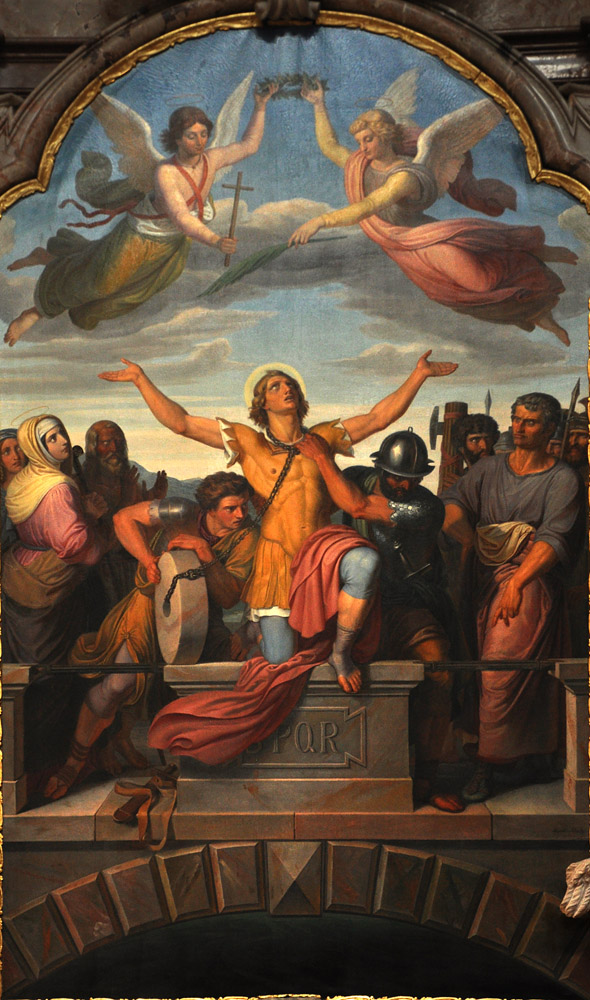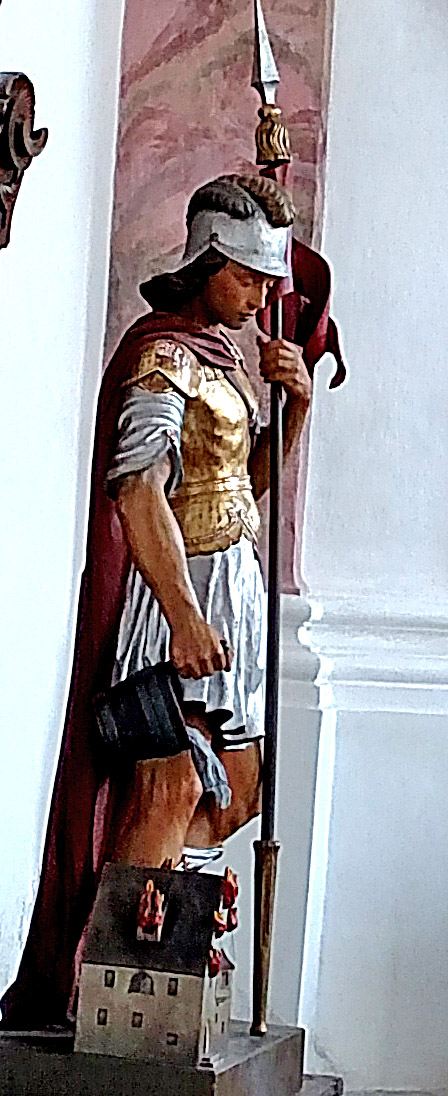According to the 9th-century Passion of St. Florian the saint was a military officer and a martyr. His images always have him in Roman or medieval military garb but often omit the martyr's palm branch. His blond hair will be long and flowing, and he is almost always beardless.
The Passion has him called before the prefect Aquilinus during the Diocletian persecutions. Hearing the saint's refusal to worship the gods, Aquilinus orders him beaten with cudgels. That does not break his will, so the prefect has his shoulders flayed. Florian still refuses to comply, so the prefect tells his soldiers to take him to a bridge that crosses the Enns River, tie him to a stone, and toss him in. On arrival at the bridge, Florian asks for time to pray. The guards agree, and he prays with his arms extended like Christ's arms on the cross. After an hour like this, an impatient youth rushes forward and pushes Florian into the river. This sequence is the subject of a sequence of frescos on the ceiling of St. Florian's Abbey in Austria. According to the Passion, the abbey is the site where Florian's body was interred. His body washed up on the shore of the river, where Christ sent an eagle to guard it until a Christian woman found it and buried it at the site where the abbey stands today.
 The "Saint Florian Cross" is the basis for identifying shields used by a great many fire departments in Europe and the Americas.
The "Saint Florian Cross" is the basis for identifying shields used by a great many fire departments in Europe and the Americas.
Prepared in 2014 by Richard Stracke, Emeritus Professor of English, Augusta University. Revised 2017-05-15, 2018-03-10. Source of the "Saint Florian Cross": Wikimedia Commons.
HOME PAGE

Schultz's 19th-century Martyrdom of St. Florian follows the Passion in nearly every detail. (See the description page.)

A statue of Florian in South Tyrol, Italy (See the description page.)
ATTRIBUTES
- Pouring water from a bucket
- Military garb
MORE IMAGES
- Late 15th century: Linden wood statue of Florian extinguishing a castle fire.
- Late 17th/Early 18th century: The Glory of St. Florian, in St. Florian's Abbey, Austria
- Mid-18th century: Shrine in the St. Florian Chapel in St. Peter's, Munich.
DATES
- Feast day: May 4
BIOGRAPHY
- Two versions of The Passion of St. Florian are printed, along with introductory material, in the Acta Sanctorum (May vol. 1, 461-67). They can also be read in English translation in Woods.
- Passio Floriani, in MHG: Scriptores Rerum Merovingicarum, III, 65-71.
NOTES
1 Specifically, in Baden-Württemberg.
2 Many web sites say the bucket image illustrates an old medieval legend, but I have been unable to find any literary record of such a tale. Godfrey Henschen's comprehensive article on St. Florian in the Acta Sanctorum reports that people have prayed to St. Florian "in every age" for protection against house fires, and that he has been the patron saint of carbonarii, "carbon-burners" (Acta Sanctorum, May vol. 1, 462). However, there is not a word about a bucket legend in his introduction nor in the vitae he includes. That volume of the Acta Sanctorum was published in 1680, so one must assume that no literary records of the bucket story were available at that time. Some have suggested that the saint's connection with fire may have arisen from his comment during his tortures, si autem vis scire quia non timeo tormenta tua, ignem accende; et in nomine Domini mei Jeus Christi ascendo super eum, "If you want to know why I do not fear your torments, light a fire, and in the name of my Lord Jesus Christ I will climb upon it" (AASS, ibid.). In this theory Florian's comment about not fearing fire would have led to Christians praying for his help against fire, which then would have led to the bucket legend and the images that go with it. (It remains unclear whether the legend led to the images or vice-versa.)